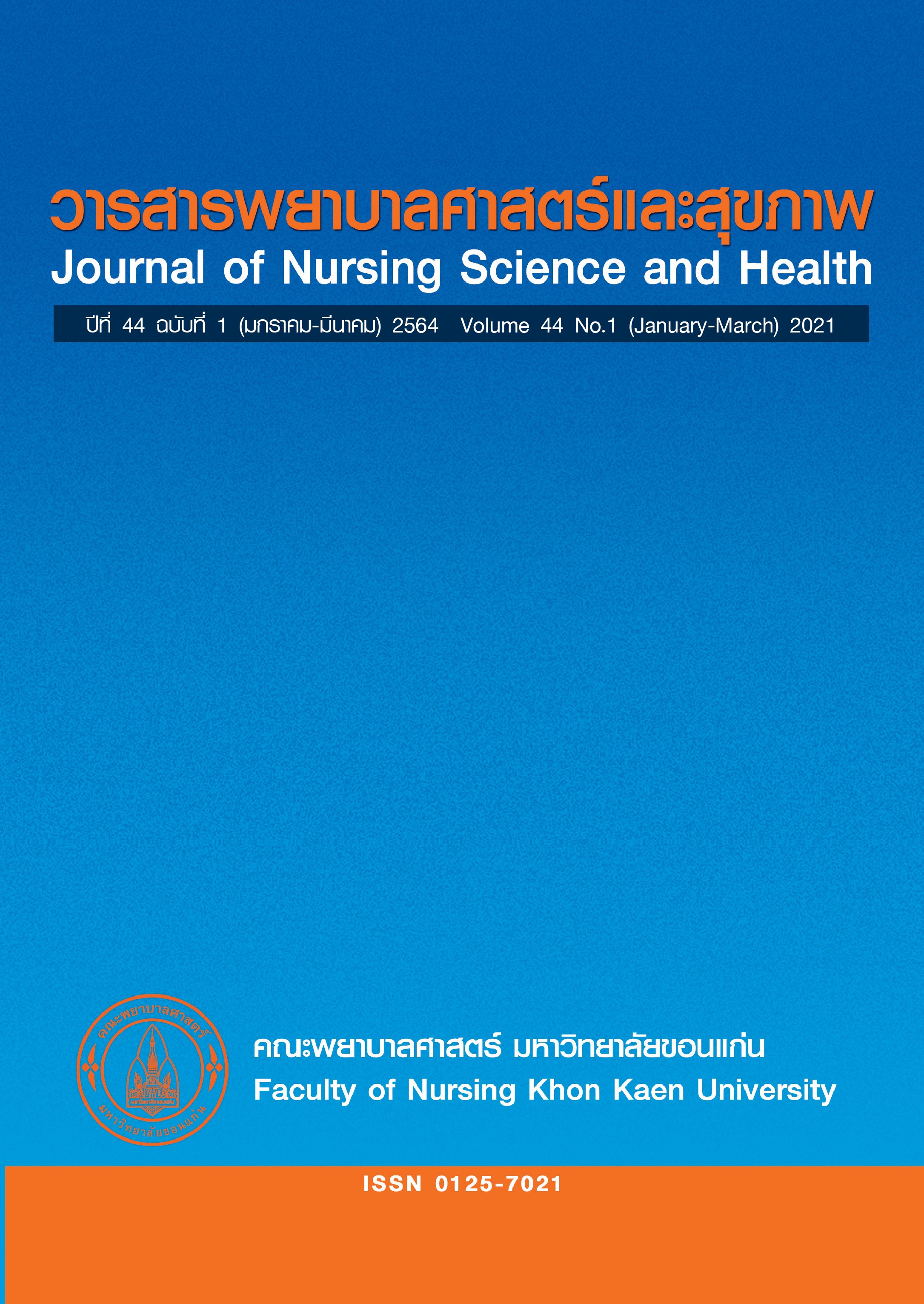การประเมินผลหลักสูตรการพยาบาลเฉพาะทาง สาขาการจัดการทางการพยาบาล คณะพยาบาลศาสตร์ มหาวิทยาลัยขอนแก่น
คำสำคัญ:
การประเมินผลหลักสูตร, การจัดการทางการพยาบาล, หลักสูตรเฉพาะทาง, รูปแบบ CIPPบทคัดย่อ
การวิจัยประเมินผลนี้มีวัตถุประสงค์เพื่อประเมินผลหลักสูตรการพยาบาลเฉพาะทาง สาขาการจัดการทางการพยาบาล คณะพยาบาลศาสตร์ มหาวิทยาลัยขอนแก่น โดยใช้แบบจำลองซิป (context, input, process, and product evaluation (CIPP) model) กลุ่มตัวอย่างคือผู้สำเร็จการอบรมจำนวน 190 คนจากหลักสูตรรุ่นโครงการปกติ 2 รุ่น และรุ่นโครงการพิเศษ 4 รุ่น เก็บข้อมูลด้วยแบบสอบถามที่ผู้วิจัยสร้างขึ้น มีค่าความเชื่อมั่นของแบบสอบถามทั้งฉบับ เท่ากับ .98 วิเคราะห์ข้อมูลด้วยสถิติเชิงพรรณนาและการเปรียบเทียบใช้สถิติการทดสอบค่าที ผลการวิจัยพบว่า ผู้สำเร็จการอบรมมีความคิดเห็นเกี่ยวกับด้านบริบท ด้านปัจจัยนำเข้า ด้านกระบวนการ และด้านผลผลิตของการจัดหลักสูตรในระดับมากทุกด้าน ความคิดเห็นของผู้สำเร็จการอบรมในรุ่นโครงการปกติกับรุ่นโครงการพิเศษเกี่ยวกับปัจจัยนำเข้ามีความแตกต่างกันอย่างมีนัยสำคัญทางสถิติที่ระดับ .05 ส่วนด้านบริบท ด้านกระบวนการ และด้านผลลัพธ์ไม่แตกต่างกัน
เอกสารอ้างอิง
Krairiksh M. Nursing leadership for the service plan. Thai Journal of Nursing 2015; 64(2):55-61. (in Thai)
NursingDivisionMinistryofPublicHealth.Roles and functions of professional nurses. Bangkok: Sutawan Publishing Company; 2018.(in Thai)
Thosuwanajinda W. Human resource management. 4th ed. Bangkok: B.J. Plate Processor; 2008. (in Thai)
Luepong P. The Competency development of human resource. Executive Journal 2012;32(4):103-8. (in Thai)
StufflebeamDL, The CIPPmodel forevaluation. In: Stufflebeam DL, Madaus and and TGF. Kellaghan (eds) Evaluation models. 2nd eds. Boston: Kluwer Academic Publishers. Springer Netherlands; 2000:p.279-317 (Chapter 16).
Zhang G, Zeller N, Griffith R, Metcalf D, Williams J, Shea C, Misulis K. Using the context, input, process, and product evaluation model (CIPP) as a comprehensive framework to guide the planning, implementation, and assessment of service-learning programs. Journal of Higher Education Outreach and Engagement 2011;15(4):57-84.
Kijkuakul S, Bongkotphet T. Evaluation of master of education in science education program (revised 2009) Facultyof Education, Naresuan University. Journal of Education Naresuan University 2014;16(1):140−8. (in Thai)
PolitDF,BeckCT. Nursingresearch: Generating and assessing evidence for nursing practice. 10th Ed. Philadelphia Wolters Kluwer Health; 2017.
Naiyapatana W. The evaluation of nursing specialty in nursing administration program, The Royal Thai Army College. Journal of Nursing and Education 2010;3(2):2−15. (in Thai)
Ronnarithivichai C, Pasunant N, Petchpansri S. An evaluation of the geriatric nursing specialty program facultyofnursing,Mahidol University. Journal of gerontology and geriatric medicine 2003;4(1):3-9. (in Thai)
Khiewchaum R. The Evaluation of the program in nursing specialty in nurse practitioner (primary medical care) class 3 Phrapokklao Nursing College. Journal of Phrapokklao Nursing College 2013;24(1):22-31. (in Thai)
ดาวน์โหลด
เผยแพร่แล้ว
รูปแบบการอ้างอิง
ฉบับ
ประเภทบทความ
สัญญาอนุญาต
วารสารพยาบาลศาสตร์และสุขภาพเป็นเจ้าของลิขสิทธิ์ในการเผยแพร่ผลงานที่ตีพิมพ์ห้ามผู้ใดนำบทความที่ได้รับการตีพิมพ์ในวารสารพยาบาลศาสตร์และสุขภาพไปเผยแพร่ในลักษณะต่าง ๆ ดังนี้ การนำบทความไปเผยแพร่ออนไลน์ การถ่ายเอกสารบทความเพื่อกิจกรรมที่ไม่ใช่การเรียนการสอน การส่งบทความไปตีพิมพ์เผยแพร่ที่อื่น ยกเว้นเสียแต่ได้รับอนุญาตจากวารสารพยาบาลศาสตร์และสุขภาพ



